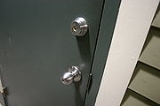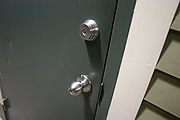
Deadbolt
Encyclopedia

Lock (device)
A lock is a mechanical or electronic fastening device that is released by a physical object or secret information , or combination of more than one of these....
distinct from a spring bolt lock
Spring bolt lock
A spring bolt lock, also known as a night latch, is where a locking mechanism is used with a latch bolt.* For information on locks, see Lock * For spring bolt lock used as a latch, see Latch* For comparison of use, see Dead bolt lock...
because a deadbolt cannot be moved to the open position except by rotating the lock cylinder. The more common spring bolt lock uses a spring
Spring (device)
A spring is an elastic object used to store mechanical energy. Springs are usually made out of spring steel. Small springs can be wound from pre-hardened stock, while larger ones are made from annealed steel and hardened after fabrication...
to hold the bolt in place, allowing retraction by applying force to the bolt itself. A deadbolt can therefore make a door more resistant to entry without the correct key
Key (lock)
A key is an instrument that is used to operate a lock. A typical key consists of two parts: the blade, which slides into the keyway of the lock and distinguishes between different keys, and the bow, which is left protruding so that torque can be applied by the user. The blade is usually intended to...
.
A deadbolt is often used to complement a spring-bolt lock on an entry door to a building.
Common types
A deadlock, if it is cylinder operated, may be either single cylinder or double cylinder. A single cylinder deadlock will accept a key on one side of the lock, but is operated by a twist knob on the other side. Double cylinder locks will accept a key on both sides and therefore do not require (and often do not have) any twist knob. This prevents unwanted unlocking of the door by forced access to the interior twist knob (via a nearby window, for example). Some lock manufacturers also have a "lockable" knob: there a key is always needed on one side (usually external), and a twist knob can be used on the other (internal), unless a button has been pressed, in which a key is also needed on the (internal) side.A variant of the standard deadbolt is the vertical deadbolt, invented by Samuel Segal
Segal Lock and Hardware Company
The Segal Lock and Hardware Company of Manhattan, New York was a leading manufacturer of hardware merchandise and razor blades in the1920s and 1930s. First established in Connecticut and Manhattan, the firm relocated to Brooklyn, New York in the mid 1920s. The Segal Safety Razor Corporation was a...
. Vertical deadbolts resist jimmying, in which an intruder inserts a pry bar
Crowbar (tool)
A crowbar, a wrecking bar, pry bar, or prybar, or sometimes a prise bar or prisebar, and more informally a jimmy, jimmy bar, jemmy or gooseneck is a tool consisting of a metal bar with a single curved end and flattened points, often with a small fissure on one or both ends for removing nails...
between the door and the jamb and attempts to pry the bolt out of the door.
Other types of deadbolts include:
- Single Cylinder with removable thumb-turn
- Classroom Function (thumb-turn only unlocks door)
- Exit Only Function (no external cylinder)
- Push-button Deadbolt (mechanical or electrical)
Security considerations
A deadlock can provide more security than the spring bolt lock for a number of reasons.- One must have a key to open the door. This discourages intruders since the easy "just open the door" option is unavailable; they cannot hope for a quick getaway, e.g. if they find the premises are occupied.
- There are techniques of opening a spring bolt door that work by using a suitable implement to push on the bolt. As the bolt is only held in place by a spring, the force required to open it is within reach of a blade similar to a paint chipper.
But with a deadlock, it would take a serious amount of force to cause the bolt to move without the key, and this force is considered impractical to deliver ... the practicality is that it would be easier to just attack the door with the aim of removing the lock, or removing the door off its hinges, or removing the door jamb, than to aim to move the bolt of the deadlock.
- The 2nd type of lock, with perhaps a second method of picking, possibly a far smarter lock design than the standard tumbler, would make it more obvious that the lock pick was not using a key to open it, thus exposing the lock pick to being identified.
- As the door is only locked by using a key, and it can only be locked when it is closed properly, closing the door and ensuring it is properly closed and locked becomes a habit. With doors that can be locked before being closed, or spring bolt locks, the bolt may fail to engage the door jamb due to forgetfulness, misalignment, obstruction or malfunction.
- A double cylinder deadlock without a twist knob cannot be opened without a key. This design may be suitable for doors with glass sections, or doors with nearby windows, since a deadlock with an internal twist knob may be opened by penetrating the nearby glass and reaching the knob.
Many designs are available from manufacturers. Various manufacturers have patented designs offering unique solutions to prevent the locks from being defeated by picking, lock bumping
Lock bumping
Lock bumping is a lock picking technique for opening a pin tumbler lock using a specially crafted bump key. One bump key will work for all locks of the same type.-History:A US patent first appears in 1928 by H.R. Simpson called a "rapping" or bump-key...
, prying, and other forceful attacks.

